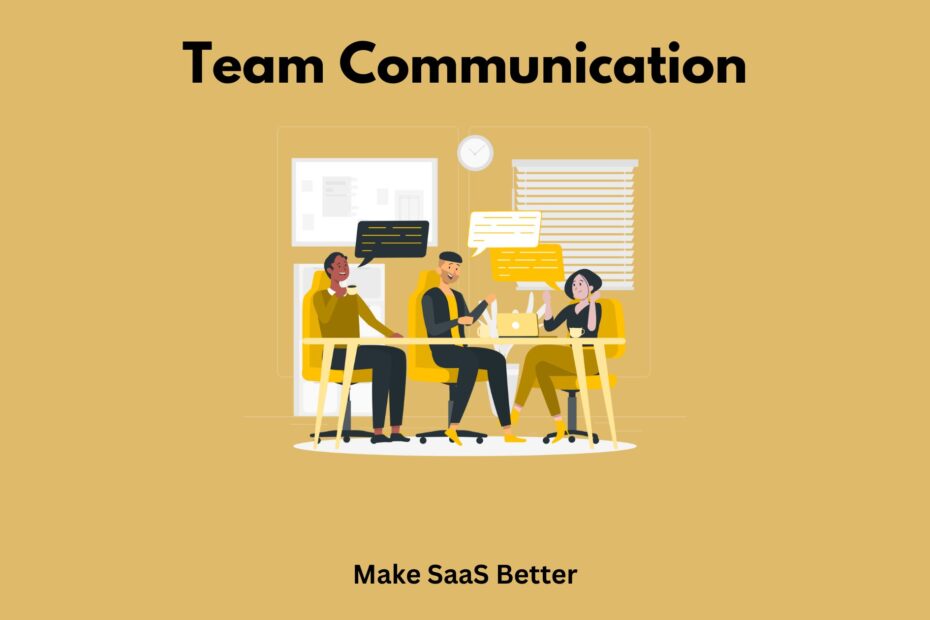Communication isn’t just a soft skill. It’s the lifeblood of any successful team. When teams communicate well, things get done. When they don’t, things fall apart. Fast.
Think about it. A recent study showed that 86% of employees blame workplace failures on poor communication. This isn’t just anecdotal. Another study found miscommunication costs US businesses $1.2 trillion annually. That’s real money, down the drain.
But here’s the upside: companies with clear communication strategies see 4.5 times higher employee retention. People stay when they feel heard. And teams that talk effectively? They can see up to a 25% increase in productivity.
Furthermore, 72% of business leaders report that effective communication directly leads to higher productivity. This isn’t fluff. It’s the engine of progress.
What Is Team Communication?
Team communication is simply the way people in a group share information, ideas, and feedback. It’s how they connect, coordinate efforts, and stay on the same page.
It’s not just about talking; it’s about understanding. It’s about building a shared reality. Without it, a group is just a collection of individuals. They’re moving in different directions, bumping into walls. With it, they become a unit, a single force, working towards a common goal.
This exchange can be formal, like a scheduled meeting, or informal, like a quick chat by the water cooler. Every interaction, big or small, shapes how a team functions. It’s the invisible thread that binds them.
Why Is Team Communication Important?
Team communication is crucial because it drives everything a team does. It makes sure everyone knows their role and what’s expected. This clarity cuts down on confusion and wasted effort.
Imagine a project where no one knows who does what. Chaos. When people talk, they can share insights, spot problems early, and come up with solutions together. It builds trust, too. Knowing you can speak freely, give feedback, and be heard creates a safe space. This leads to higher morale.
Disengaged employees are a problem for any business, a silent killer, and poor communication is a big reason for that.
Teams with strong communication are five times more likely to be high-performing. It’s not just about tasks; it’s about human connection at work. It’s about creating a machine that works.
Types of Team Communication
1. Verbal Communication

This is communication through spoken words. Also known as oral communication. It happens in meetings, phone calls, video conferences, or quick hallway chats. It’s direct and often instant. The benefit of oral communication is immediate feedback and the ability to gauge reactions. You see the nod. You hear the tone.
Think of a project kickoff meeting where the leader explains the vision and answers questions on the spot. No waiting. No guessing. It’s raw and immediate.
2. Written Communication

This type relies on the written word. Emails, chat messages, reports, documents, and project plans fall into this category. It’s good for detailed information, keeping records, and communicating across different time zones. It’s your paper trail.
For example, a team might use a shared document to outline project requirements, allowing everyone to contribute and review asynchronously. You don’t need to be in the same room. Or even awake at the same time. It builds clarity through documentation.
3. Non-Verbal Communication

This includes body language, facial expressions, gestures, and even tone of voice. It often happens alongside verbal communication, but can also stand alone.
Non-verbal cues can tell you a lot about what someone is feeling or thinking, sometimes more than their words. A shrug. A tight jaw. These speak volumes.
A nod of understanding or a furrowed brow of confusion is a powerful message. Ignoring this is ignoring a huge chunk of the conversation. You miss the truth.
Key Components of Team Communication
1. Clarity
This means being direct and easy to understand. No jargon, no vague statements. Say what you mean. Period.
When you ask a teammate to “get that report done soon,” it’s unclear. It’s a guess. “Please send the Q2 sales report by the end of the day Friday” is clear. No doubt. Clarity cuts through noise. It removes ambiguity. It makes action possible.
2. Active Listening
This is more than just hearing words. It’s about fully focusing on the speaker, understanding their message, asking clarifying questions, and showing you’re engaged.
You’re not just waiting for your turn to talk. When a team member shares an idea, truly listening means not interrupting, letting them finish, and then summarizing what you heard to confirm understanding. It builds respect. It builds a real connection. It shows you value what they have to say, not just what you want to hear.
3. Feedback
This is giving and receiving information about performance or ideas. It should be constructive, timely, and specific. It’s a two-way street. Not a monologue.
A leader giving feedback might say, “Your presentation visuals were strong, but the data points felt rushed. Can we work on simplifying those for next time?” This helps people grow. It’s how you get better. It’s how the team gets better. Without it, you just keep making the same mistakes.
4. Respect
This means valuing each team member’s input, even if you disagree. It’s about creating an environment where everyone feels safe to speak up without fear of judgment. You don’t shut people down. You listen.
This means listening to differing opinions with an open mind, even if you ultimately choose another path. It’s not about agreement; it’s about valuing the individual. It builds trust. It builds a culture where ideas can actually surface, not just the safest ones.
Consequences of Poor Team Communication
1. Missed Deadlines
When communication breaks down, tasks get missed. Information doesn’t reach the right people. project stalls. This leads to delays and often, project failure.
Imagine a marketing team launching a new product, but the content team wasn’t told about a last-minute change to the release date. The old content goes live, a public failure. The launch is a mess. Deadlines are not suggestions. Poor communication turns them into fiction. This often points to a serious communication breakdown.
2. Low Morale
Poor communication makes people feel out of the loop. They don’t feel valued or heard. This drains motivation. It kills drive.
When employees feel disconnected, their job satisfaction drops. This can lead to resentment and a lack of desire to go the extra mile. Why would they? They’re just a cog, ignored. Low morale eats away at a team from the inside out.
3. Increased Conflict
Misunderstandings breed tension. When messages are unclear, people make assumptions. These assumptions often lead to arguments and friction.
A simple email misinterpretation can cause a significant dispute between team members who otherwise work well together. Small misfires become big battles. Your team turns on itself.
4. High Turnover
Unhappy employees leave. It’s that simple. If communication is consistently poor, people will seek better environments. This means losing talent, increasing recruitment costs, and constantly training new hires. It’s a constant drain. The ripple effect on productivity and institutional knowledge is huge. You’re bleeding talent. You’re constantly starting over.
Strategies to Build Team Communication Skills
1. Set Clear Expectations
Teams need to know the rules of the game. What’s the goal? What’s my role? How will we talk to each other? Define meeting norms, response times for messages, and how decisions will be made.
For example, agree that urgent messages go through a chat tool, while less urgent updates go via email. No guesswork. No confusion. You lay the groundwork, so everyone knows the path forward. This is part of a larger strategic communication effort.
2. Encourage Open Dialogue
Create an environment where people feel comfortable sharing ideas, asking questions, and even disagreeing. This means leaders need to model vulnerability and be open to feedback themselves. You go first. Regular check-ins, beyond just status updates, can help.
Ask “What challenges are you facing?” rather than just “Is it done?” You want the truth, not just the easy answer. This creates a safe space for real talk.
3. Provide Training
Communication isn’t always innate. It’s a skill. Offer workshops on active listening, conflict resolution, or effective presentation skills. Even short, practical sessions can make a big difference.
Role-playing different communication scenarios can help people practice in a safe space. You wouldn’t expect someone to code without training. Why expect perfect communication? Give them the tools.
4. Use Multiple Channels
Different messages call for different tools. A quick question might be a chat message, a detailed update an email, and a complex discussion a video call. Don’t force every communication into one mold. Knowing when to pick up the phone instead of sending another email can save hours of back-and-forth. Use the right weapon for the right battle. Don’t limit your options.
Types of Team Communication Tools
1. Instant Messaging Platforms
These allow for quick, real-time text conversations. They are good for brief updates, quick questions, and informal chats.

Example: Slack. You can set up channels for different projects or teams, so everyone gets relevant updates quickly.
2. Video Conferencing Tools
These enable face-to-face meetings virtually. Great for remote teams, detailed discussions, or when non-verbal cues are important.

Example: Zoom. A team can hold a daily stand-up meeting, seeing each other and quickly discussing progress and roadblocks.
3. Project Management Software
These tools help teams plan, track, and manage projects. They often include features for task comments, file sharing, and progress updates.

Example: Asana. A designer can upload a new graphic, and the marketing team can leave comments directly on the image, all in one place.
4. Email
The classic. Good for formal communications, sharing documents, and updates that don’t require immediate responses.

Example: Gmail. Sending a weekly summary report to the entire team, documenting achievements and upcoming goals.
5. Document Collaboration Tools
These allow multiple people to work on the same document in real-time. Great for brainstorming, editing, and shared note-taking.

Example: Google Docs. Two writers can work on a proposal simultaneously, seeing each other’s edits and leaving comments.
6. Intranet or Internal Knowledge Bases
These act as central hubs for company information, policies, and shared resources. Good for one-to-many communication and storing important data.

Example: Confluence. A company can store HR policies, brand guidelines, and project wikis, making information accessible to everyone.
How to Increase Employee Engagement with Team Communication?
1. Regular Check-Ins
Beyond formal meetings, schedule short, informal check-ins. These can be one-on-one or small group huddles. It’s a chance to see how people are doing, address concerns early, and build relationships.
A quick 15-minute chat can prevent bigger problems later. You show you care. You show they matter, not just their output.
2. Transparent Communication
Share information openly and honestly. Explain decisions, even the tough ones. When employees understand the “why” behind things, they feel more connected and trusted. This builds confidence in leadership.
For example, explain the market conditions leading to a new company strategy, not just the strategy itself. This is vital for effective corporate communication. No secrets. No surprises. Just the truth.
3. Ask for Input and Act on It
Employees want to know that their voices matter. Regularly solicit feedback through surveys or open forums. More importantly, show that you listen by acting on what you hear.
If employees suggest a new process, and you implement it, they see their contribution has value. This closes the loop. It shows their ideas aren’t just going into a black hole. It shows you’re paying attention.
4. Celebrate Successes
Publicly acknowledge team and individual achievements. This shows appreciation and reinforces positive behaviors.
A simple shout-out in a team meeting or a company-wide email can boost morale and make people feel seen. It connects effort to outcome. It’s not just about hitting targets; it’s about recognizing the people who hit them. It fuels future success.
Conclusion
Team communication isn’t just a buzzword. It’s the backbone of every effective group, from startups to global corporations. This isn’t theoretical. It’s the engine that drives productivity, builds trust, and keeps everyone pulling in the same direction.
Ignore it, and your team drifts. It becomes a collection of silos, each operating on its island, disconnected. Misunderstandings become the norm. Projects falter. Good people leave. You bleed talent, slowly, then all at once. Your business becomes a leaky bucket, constantly trying to refill what’s draining out. This isn’t a strategy for winning. It’s a path to mediocrity, or worse.
Master it, and your team builds. It becomes a machine, sharp and precise. Ideas flow. Problems dissolve. Trust becomes the default. You retain talent. You innovate. You dominate. It’s a skill, like any other. One that demands practice, the right tools, and a relentless commitment to clear, honest talk.
Invest in it. Not just money, but time. Attention. Effort. The returns are undeniable. They’re measurable. They’re what separates the winners from the rest. The choice is yours. Build a team that talks, or watch it crumble in silence.
